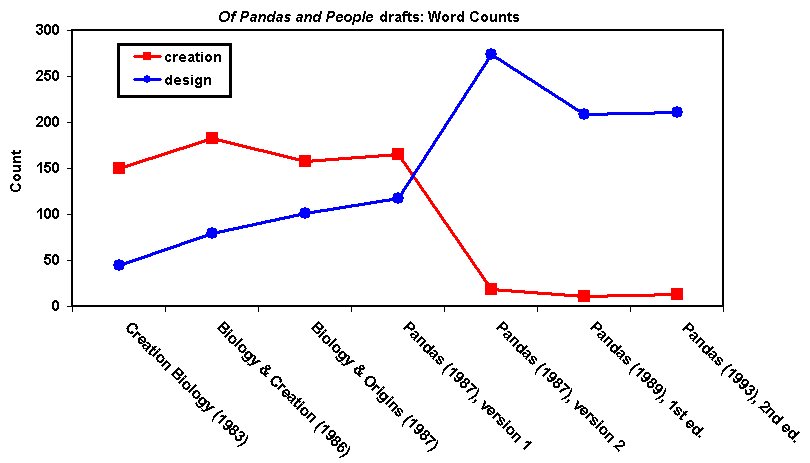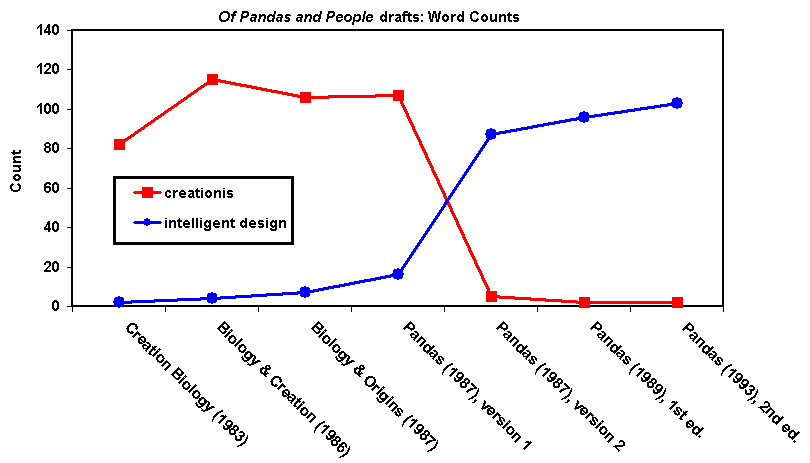I guess ID really was "Creationism's Trojan Horse" after all
 It seems like a lifetime ago now, but it was only December 7, 2004 when I posted the original “Panda-monium” post on PT, linking to NCSE’s new webpage of resources on Of Pandas and People. At the time, I was relatively new to Pandas. However, even back then it struck me that Pandas was a particularly important work, because it was published in 1989 and thus substantially predated the rest of the “intelligent design” corpus. At the time, I remarked that:
It seems like a lifetime ago now, but it was only December 7, 2004 when I posted the original “Panda-monium” post on PT, linking to NCSE’s new webpage of resources on Of Pandas and People. At the time, I was relatively new to Pandas. However, even back then it struck me that Pandas was a particularly important work, because it was published in 1989 and thus substantially predated the rest of the “intelligent design” corpus. At the time, I remarked that:
[Pandas] was the first book to frequently use now-common buzzwords such as “intelligent design,” “design proponents,” and “design theory.” As such, Pandas represents the beginning of the modern “intelligent design” movement.
My primary source for this was the Preface that Jon Buell had written for the fabled “third edition” of Pandas, to be published as The Design of Life. In the Preface, Buell (head of the Foundation for Thought and Ethics, the group that produced Pandas) wrote,
A decade has passed since Of Pandas and People’s second edition appeared in print. Written by Percival Davis and Dean Kenyon, this book was the first intelligent design textbook. In fact, it was the first place where the phrase “intelligent design” appeared in its present use.
(This Preface was freely online at William Dembski’s DesignInference.com website for much of 2004, but was taken down about the time Kitzmiller v. Dover was filed in December 2004 – see Wayback archive, where it can still be downloaded, and a May 2004 blog post quoting the beginning of Buell’s Preface.)
In 2004, one would have thought that everything that could be said about Pandas had already been said, between 15 years of negative reviews, Jay Wexler’s law review article, and Frank Sonleitner’s epic book-length critique of Pandas. However, over the course of the Kitzmiller case, a great deal of new information was learned about the origin and evolution of Pandas.
The first sentence of the Acknowledgements section of Pandas states cryptically that “Of Pandas and People went through an evolution of its own” (Pandas, 1993, p. iii). However, it was not realized how literally true this was until unpublished drafts of Pandas were subpoenaed by the Kitzmiller plaintiffs during the discovery period in the case. The basics hit the Wall Street Journal and other newspapers before Barbara Forrest testified in the trial: Pandas was conceived and written as a classic creationist “two models” text, and only later was converted into an “intelligent design” book.
Strangely, just a few days before Forrest’s testimony, the Discovery Institute released an article purporting to be a “Brief History of the Scientific Theory of Intelligent Design.” It included brand-new interviews with Charles Thaxton and other ID pioneers, and was obviously intended to rebut Forrest’s expert report. But both interviewers and interviewees neglected to mention the minor facts that Pandas was the first book to systematically use the term “intelligent design”, and that the book evolved directly from a creationist book.
When Forrest testified, many more details came out, including the names and dates of unpublished drafts of Pandas, and the fact that the switch from creationism to ID involved little change in content, and instead was merely a crude word switch between variants on “creation” and variants on “intelligent design.” Furthermore, the switch apparently occurred after the Edwards v. Aguillard decision against “creation science” was handed down by the U.S. Supreme Court on June 19, 1987. Forrest’s testimony is now online, but the short version is summarized in this New Scientist article, “Book thrown at proponents of Intelligent Design”.
Since I don’t think it has been blogged, for posterity, here is the list of the known drafts of Pandas that were introduced in the Kitzmiller case last Wednesday:
Creation Biology (1983) Biology and Creation (1986) Biology and Origins (1987) Of Pandas and People (1987, version 1, creationist version) Of Pandas and People (1987, version 2, “intelligent design” version) Of Pandas and People (1989, published 1st edition) Of Pandas and People (1993, published 2nd edition)
Only after after Forrest testified did the ID movement finally bring itself to acknowledge, in a vague way, the existence of this skeleton in their closet. On October 6 the Discovery Institute put out “ Dover Trial Witness Plays Misleading Word Games In Effort to Redefine Intelligent Design.” Make sure you are not drinking anything before you read the article.
“It was only in that very generic sense that the book used the notion of “creation” – that is, that signs of plan, purpose, and intelligence in nature point to an intelligent cause,” added Luskin. “Pandas makes it explicitly clear in many instances that they are not postulating a supernatural cause, because to do so would go beyond the limits of science. No ‘word-processor-conspiracy-theory’ from Forrest can change the fact that Pandas’ arguments were always distinct from those of traditional ‘creationism’.”
The “word-processor-conspiracy-theory” bit is apparently a reference to this sequence of quotes that Forrest displaying from the Pandas drafts during her testimony:
Creation means that the various forms of life began abruptly through the agency of an intelligent creator with their distinctive features already intact–fish with fins and scales, birds with feathers, beaks, and wings, etc. (Biology and Creation 1986, FTE 3015, p. 2-10)
Creation means that various forms of life began abruptly through the agency of an intelligent Creator with their distinctive features already intact–fish with fins and scales, birds with feathers, beaks, and wings, etc. (Biology and Origins 1987, FTE 3235, p. 2-13)
Creation means that various forms of life began abruptly through the agency of an intelligent Creator with their distinctive features already intact–fish with fins and scales, birds with feathers, beaks, and wings, etc. (Pandas 1987, creationist version, FTE 4996-4997, pp. 2-14, 2-15)
Intelligent design means that various forms of life began abruptly through an intelligent agency, with their distinctive features already intact–fish with fins and scales, birds with feathers, beaks, and wings, etc. (Pandas 1987, intelligent design version, FTE 4667, p. 2-15)
Intelligent design means that various forms of life began abruptly through an intelligent agency, with their distinctive features already intact – fish with fins and scales, birds with feathers, beaks, and wings, etc. (Pandas 1989, 1st edition, published, pp. 99-100)
Intelligent design means that various forms of life began abruptly through an intelligent agency, with their distinctive features already intact – fish with fins and scales, birds with feathers, beaks, and wings, etc. (Pandas 1993, 2nd edition, published, pp. 99-100)
Well, I guess “intelligent design” really is creationism after all. Can anyone seriously argue that this refers to anything other than special creation?
But perhaps this change was isolated, just one instance in hundreds of pages? Forrest was asked about this in court. In response, she put up the following two charts. (These charts have been put up on the ACLU-PA blog, so they are released to the public. Hat-tip to Red State Rabble for noticing the blogpost. I happen to have less blurry versions that I am posting here.) Each chart contains word counts for each draft.
The first chart shows the number of times the character strings “creation” and “design” appear in the drafts. These strings can appear in a number of contexts (“creationism”, “creation means…”, “design theory”), but nevertheless there is one obvious, dramatic change across the drafts:

However, there are a few contexts in the drafts where the words “creation” and “design” might not refer to creationism and intelligent design. So, a second search was done on the more specific strings “creationis” (catches “creationism” and “creationist”, etc.) and “intelligent design”:

As you can see, the results are even more dramatic.
There is more to say both about the drafts (this just scratches the surface!), about the story of how their existence was uncovered (This is why NCSE is important. Join NCSE!), and about the implications (many of the top ID proponents must have known about this, and have been hiding it for over 15 years). But much of it will have to wait until after the trial, and in any event this is a stunning enough development that it will take awhile for the significance to sink in. For the moment it is enough to say that any future writing on the history of the ID movement will have to take these facts into account in order to be credible.
